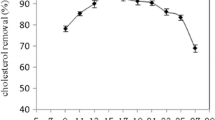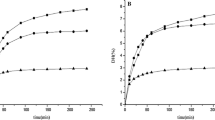Abstract
In this study, the effect of external treatment conditions [i.e., heat treatment conditions, storage conditions, pH, and high-intensity ultrasound (HIU)] on the stability of low-density lipoprotein (LDL) in egg yolk plasma modified by phospholipase A2 (PLA2) was studied. Asymmetrical flow field-flow fractionation (AF4) coupled with ultraviolet–visible (UV/Vis), multiangle light scattering (MALS) and differential refractive index (dRI) detectors was employed for the analysis of LDL modified with PLA2. The AF4 results show that PLA2 modification enhanced the stability of LDL in terms of heat treatment and −18 °C storage. However, the extent of aggregation of PLA2-modified egg yolk plasma with HIU treatment (400 W for 10 min) was larger than that of raw egg yolk plasma, and the stability decreased. Alkaline condition (i.e., pH 10) promoted the aggregation of egg yolk plasma regardless of modification with PLA2. The increased knowledge of how external factors studied in this work affect the stability of PLA2-modified LDL could increase the understanding and controlling of properties of the food made of the egg yolk.





Similar content being viewed by others
References
M. Andersson, B. Wittgren, K.G. Wahlund, Accuracy in multiangle light scattering measurements for molar mass and radius estimations. Model calculations and experiments. Anal. Chem. 75(16), 4279–4291 (2003)
T. Strixner, U. Kulozik, Continuous centrifugal fractionation of egg yolk granules and plasma constituents influenced by process conditions and product characteristics. J. Food Eng. 117(1), 89–98 (2013)
M. Anton, V. Martinet, M. Dalgalarrondo, V. Beaumal, E. David-Briand, H. Rabesona, Chemical and structural characterisation of low-density lipoproteins purified from hen egg yolk. Food Chem. 83(2), 175–183 (2003)
M. Le Denmat, M. Anton, V. Beaumal, Characterisation of emulsion properties and of interface composition in O/W emulsions prepared with hen egg yolk, plasma and granules. Food Hydrocoll. 14(6), 539–549 (2000)
F. Guilmineau, U. Kulozik, Impact of a thermal treatment on the emulsifying properties of egg yolk. Part 1: effect of the heating time. Food Hydrocoll. 20(8), 1105–1113 (2006)
F. Guilmineau, U. Kulozik, Impact of a thermal treatment on the emulsifying properties of egg yolk. Part 2: effect of the environmental conditions. Food Hydrocoll. 20(8), 1114–1123 (2006)
C.E. Dutilh, W. Groger, Improvement of product attributes of mayonnaise by enzymic hydrolysis of egg yolk with phospholipase A2. J. Sci. Food Agric. 32(5), 451–458 (1981)
K. Daimer, U. Kulozik, Impact of a treatment with phospholipase A2 on the physicochemical properties of hen egg yolk. J. Agric. Food Chem. 56(11), 4172–4180 (2008)
Y. Mine, Structural and functional changes of hen’s egg yolk low-density lipoproteins with phospholipase A2. J. Agric. Food Chem. 45(12), 4558–4563 (1997)
H. Dou, X. Zhang, A. Zhang, J. Choi, J. Wang, S. Shen, W. Zhang, Y. Li, L. Ding, S. Lee, Study on external factors affecting egg yolk plasma by asymmetrical flow field-flow fractionation. Food Res. Int. 94, 13–19 (2017)
K. Daimer, U. Kulozik, Oil-in-water emulsion properties of egg yolk: effect of enzymatic modification by phospholipase A2. Food Hydrocoll. 23(5), 1366–1373 (2009)
T. Strixner, R. Würth, U. Kulozik, Combined effects of enzymatic treatment and spray drying on the functional properties of egg yolk main fractions granules and plasma. Dry. Technol. 31(13–14), 1485–1496 (2013)
D. Gazolu-Rusanova, F. Mustan, Z. Vinarov, S. Tcholakova, N. Denkov, S. Stoyanov, J.W.J. de Folter, Role of lysophospholipids on the interfacial and liquid film properties of enzymatically modified egg yolk solutions. Food Hydrocoll. 99, 105319 (2020)
J.C. Giddings, Field-flow fractionation: analysis of macromolecular, colloidal, and particulate materials. Science 260(5113), 1456–1465 (1993)
K.-G. Wahlund, J.C. Giddings, Properties of an asymmetrical flow field-flow fractionation channel having one permeable wall. Anal. Chem. 59(9), 1332–1339 (1987)
D. Haute, W. Jiang, T. Mudalige, Evaluation of size-based distribution of drug and excipient in amphotericin B liposomal formulation. Int. J. Pharm. 569, 118603 (2019)
C.R.M. Bria, F. Afshinnia, P.W. Skelly, T.M. Rajendiran, P. Kayampilly, T.P. Thomas, V.P. Andreev, S. Pennathur, K.R. Williams, Asymmetrical flow field-flow fractionation for improved characterization of human plasma lipoproteins. Anal. Bioanal. Chem. 411, 777–786 (2018)
M. Amde, Z.Q. Tan, J. Liu, Separation and size characterization of zinc oxide nanoparticles in environmental waters using asymmetrical flow field-flow fractionation. Talanta 200, 357–365 (2019)
X. Zhang, Y. Li, S. Shen, S. Lee, H. Dou, Field-flow fractionation: a gentle separation and characterization technique in biomedicine. Trends Anal. Chem. 108, 231–238 (2018)
M.H. Moon, Flow field-flow fractionation: recent applications for lipidomic and proteomic analysis. Trends Anal. Chem. 118, 19–28 (2019)
M. Marioli, W. Kok, Recovery, overloading, and protein interactions in asymmetrical flow field-flow fractionation. Anal. Bioanal. Chem. 411(11), 2327–2338 (2019)
X. Zhao, T. Xing, X. Xu, G. Zhou, Influence of extreme alkaline pH induced unfolding and aggregation on PSE-like chicken protein edible film formation. Food Chem. 319, 126574 (2020)
H. Dou, E. Magnusson, J. Choi, F. Duan, L. Nilsson, S. Lee, Study on aggregation behavior of low density lipoprotein in hen egg yolk plasma by asymmetrical flow field-flow fractionation coupled with multiple detectors. Food Chem. 192, 228–234 (2016)
P. Guo, Y. Li, J. An, S. Shen, H. Dou, Study on structure–function of starch by asymmetrical flow field-flow fractionation coupled with multiple detectors: a review. Carbohydr. Polym. 226, 115330 (2019)
B. Wittgren, K.-G. Wahlund, H. Dérand, B. Wesslén, Aggregation behavior of an amphiphilic graft copolymer in aqueous medium studied by asymmetrical flow field-flow fractionation. Macromolecules 29(1), 268–276 (1996)
B. Zimm, The scattering of light and the radial distribution function of high polymer solutions. J. Chem. Phys. 16, 1093–1099 (1948)
M. Andersson, B. Wittgren, K.G. Wahlund, Accuracy in multiangle light scattering measurements for molar mass and radius estimations. Model calculations and experiments. Anal. Chem. 75(16), 4279–4291 (2003)
M. Primacella, T. Wang, N.C. Acevedo, Characterization of mayonnaise properties prepared using frozen-thawed egg yolk treated with hydrolyzed egg yolk proteins as anti-gelator. Food Hydrocoll. 96, 529–536 (2019)
F. Speroni, M.C. Puppo, N. Chapleau, M. de Lamballerie, O. Castellani, M.C. Anon, M. Anton, High-pressure induced physicochemical and functional modifications of low-density lipoproteins from hen egg yolk. J. Agric. Food Chem. 53(14), 5719–5725 (2005)
Y. Xie, J. Wang, Y. Shi, Y. Wang, L. Cheng, L. Liu, N. Wang, H. Li, D. Wu, F. Geng, Molecular aggregation and property changes of egg yolk low-density lipoprotein induced by ethanol and high-density ultrasound. Ultrason. Sonochem. 63, 104933 (2020)
Acknowledgements
The authors acknowledge the support provided by the Nature Science Foundation of Hebei Province (B2016201002 and H2020201295), the Key Project of Hebei Education Department (ZD2019009), the Medical Science Foundation of Hebei University (2020A08), and the Post-graduate’s Innovation Fund Project (hbu2020ss056 and hbu2021ss023).
Author information
Authors and Affiliations
Corresponding authors
Ethics declarations
Conflict of interest
The authors have no conflict of interest to declare.
Additional information
Publisher’s Note
Springer Nature remains neutral with regard to jurisdictional claims in published maps and institutional affiliations.
Rights and permissions
About this article
Cite this article
Chen, X., Guo, Y., Song, T. et al. Investigation on the stability of low‐density lipoproteins modified by phospholipase A2 using asymmetrical flow field‐flow fractionation. Food Measure 15, 3350–3356 (2021). https://doi.org/10.1007/s11694-021-00918-6
Received:
Accepted:
Published:
Issue Date:
DOI: https://doi.org/10.1007/s11694-021-00918-6




